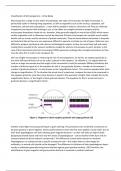Essay
Unit 17 Aims A,B: Classification of Microorganisms Assignment (DISTINCTION)
- Course
- Institution
This is my distinction grade assignment for unit 17 aims A and B on microscopy and the classification of microorganisms. All criteria were met and I was awarded distinction. If you have any questions or concerns, please do not hesitate to get in touch. I hope you find my assignment helpful!
[Show more]



